Architect Robert Adam | Daniel Andries' Travel Diary
Daniel Andries’ Travel Diary
While in the United Kingdom gathering footage and interviewing people for Architect Robert Adam: A Place at the Table, producer Daniel Andries also took tons of photographs. He recounts his trip and shares some of his favorite images here.
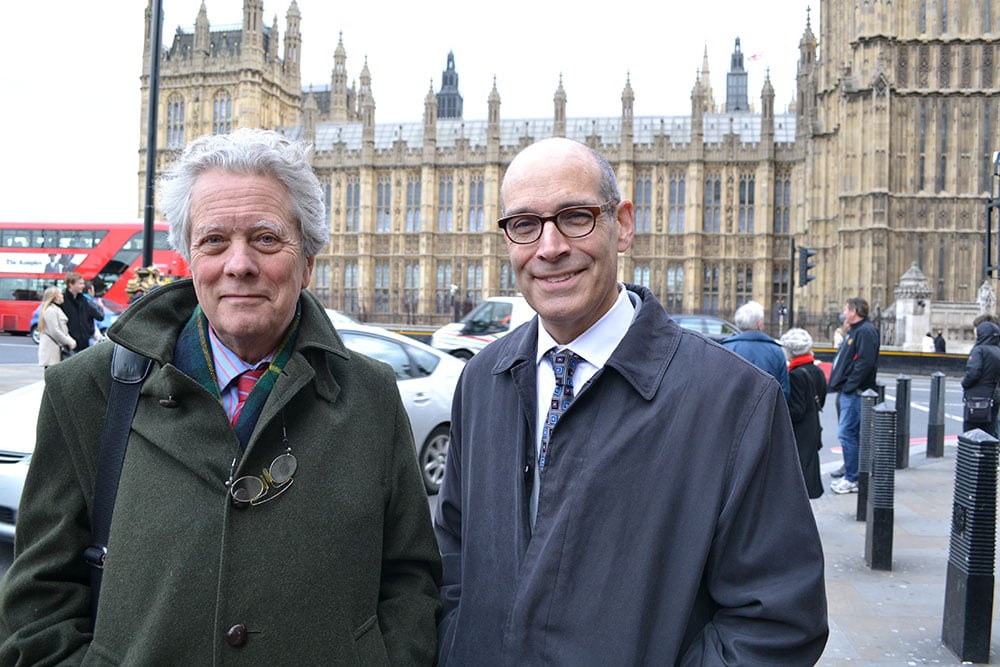
Meeting Robert Adam
This photo was taken in London within minutes of our first meeting with Robert Adam, the subject of our documentary. He had written us an email earlier proposing that “We could meet at 12.30 under the statue of Boudicea at end of Westminster Bridge right by the Houses of Parliament. You can't miss it, a bare-breasted woman in a chariot all in bronze!” We didn’t miss it. He and Geoffrey went off together to have lunch at a private club and the rest of us crossed to the South Bank where we could eat fish and chips and visit the Tate Modern, an incredible museum housed in a former power station. Robert, who prefers to be called Bob, was great company and immediately began to feed us with the sort of details a producer needs to make a decent show – like the fact that he had secured a commitment from the President of the Royal Institute of British Architects to promise traditional architects would be a respected part of the organization’s membership after years of being outcasts. Bob said he considered it a great accomplishment. Yes, that is a pince-nez hanging from his neck.
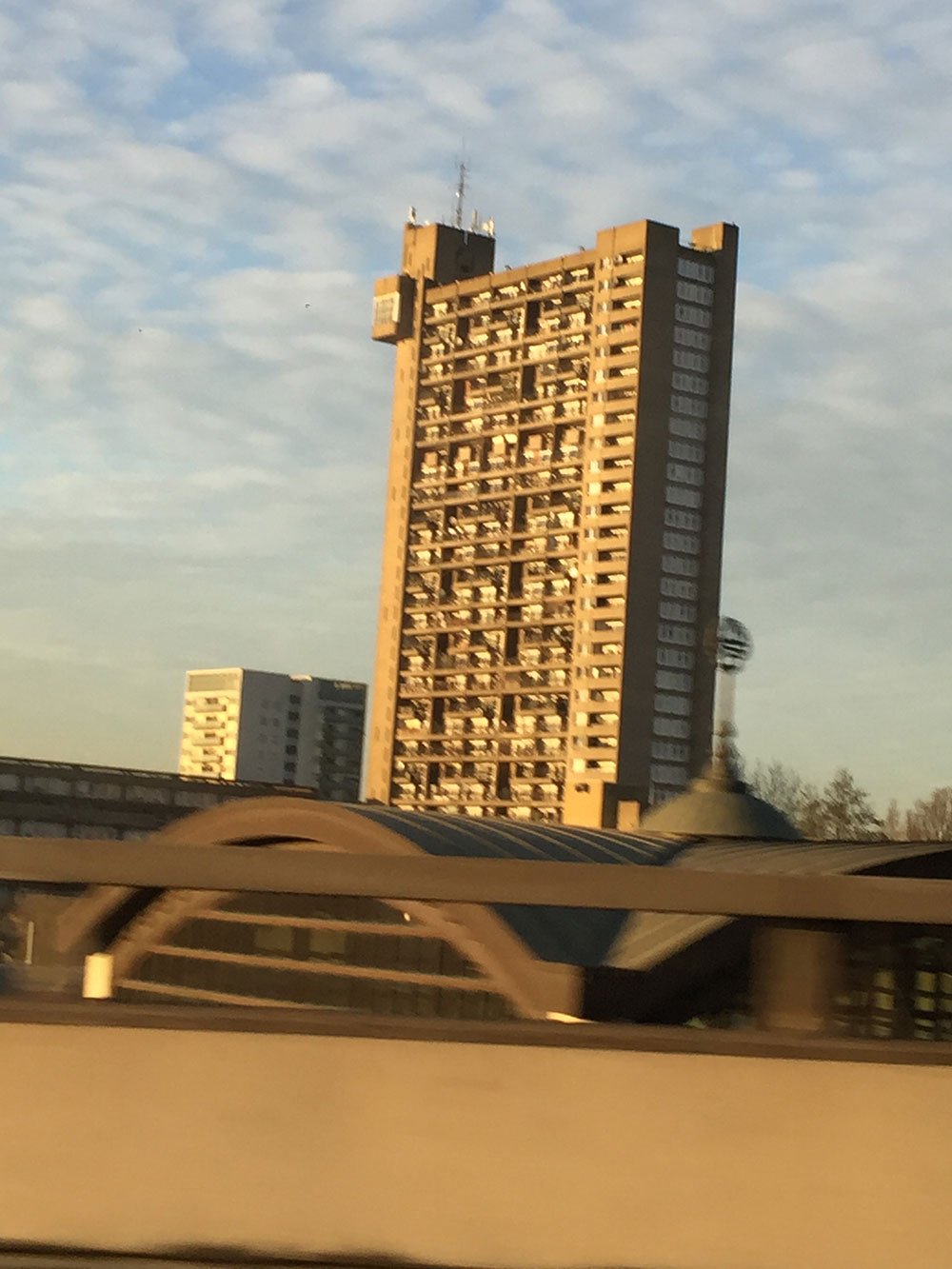 Goldfinger’s Brutalist Tower
Goldfinger’s Brutalist Tower
Because the cars are on the wrong side of the road and we don’t know England, we hired drivers and had lots of time to look out the window. One day on an elevated highway named Westway we saw this. I snapped a picture. We didn’t know what it was, but it was clearly a very striking piece of Brutalist architecture. The word Brutalist generally draws astonished laughs and a sort of amused sense of dread, but it’s an architectural historical term that actually refers to modernist buildings built between the 1950s and the 1970s with poured concrete. It comes from the French words “beton brut” – raw concrete. But Brutalism is only the first stop in the pile of words that this building carries. When we mentioned it to Bob Adam, he said “Oh yes, that’s Goldfinger.” Like in “Goldfinger?” The great Shirley Bassey-voiced James Bond title song from the 1964 movie with Sean Connery? Yes, kind of. I didn’t remember the gold-loving villain being an architect. Well, he wasn’t, but his name did come from the architect. Turns out Bond author Ian Fleming was working on a novel and went golfing with the cousin of the wife of architect Erno Goldfinger, designer of the tower in the photo. The cousin didn’t much like Erno Goldfinger and so Fleming, it is written, named his villain, and the novel, after him. Goldfinger sued Fleming and the out-of-court settlement involved insuring that the villian’s first name Auric was always linked to his last, Goldfinger. I’d say the damage was done, because it’s 2017 and I’m still thinking of James Bond when I hear the name Goldfinger. This is the Trellick Tower. One of its most striking features is the elevator tower, which can’t be seen in the picture. To get from the elevator to the building itself residents walk on covered bridges. It’s quite a structural sight. I have since read that the building, while highly regarded these days, was sort of a disaster for its original occupants.
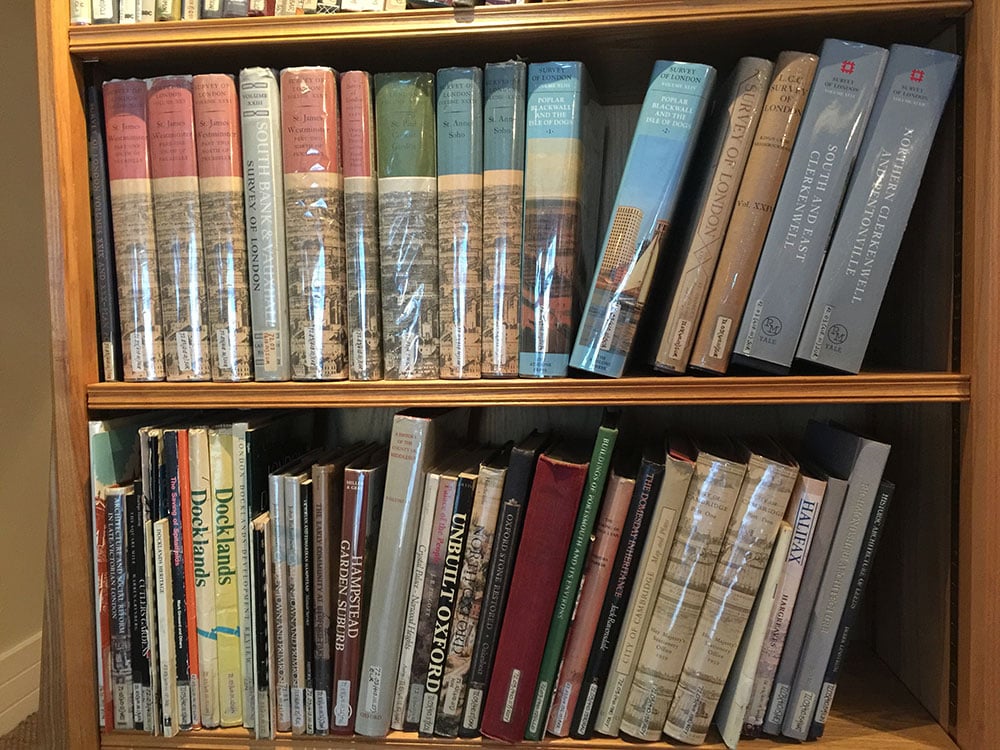
The INTBAU Library
INTBAU, said Bob Adam, sounds like the name of a German scaffolding firm. It is actually the International Network of Traditional Building, Architecture and Urbanism, an influential group of traditional architects Bob helped organize in the early part of this century. We went to the Prince’s Foundation in London’s East End to interview one of INTBAU’s only full-time employees, Harriet Wennberg. These books were in the library where we conducted the interview. Beyond being a notably arcane pile of books about London that you might expect to find in the library of the Prince’s Foundation, these books are also for the most part covered in plastic. Which means we can’t have them in the background of the shot, unless we’re happy with a bunch of really shiny reflective spines staring back at the lens and threatening to upstage the interview subject. So we moved them. Whole shelves of them. But since it was a library that we don’t run, all that had to be put back where it came from when we were done. Hence the photo – documentation so we can remember where to return the books. You can see Harriet and the library we sat her in for about 10 seconds in the finished documentary. No reflective books can be seen!
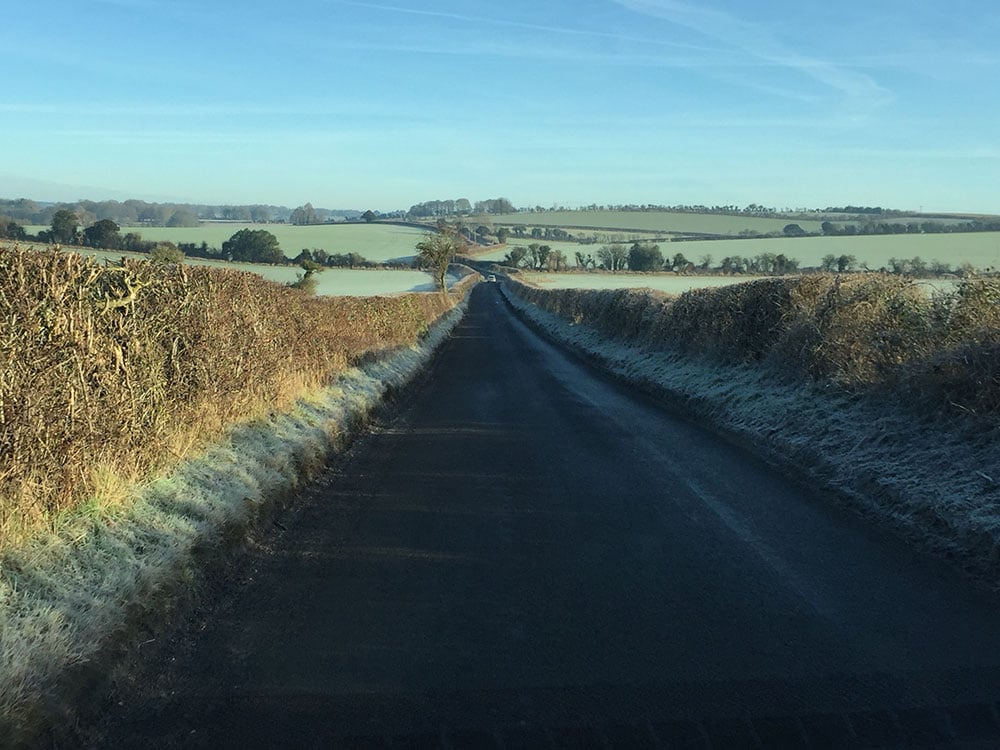
The English countryside
A view out of the window of the van one morning when the frost was still on the ground. Those are hedgerows on either side of the road, as in “If there’s a bustle in the hedgerow don’t be alarmed now, it’s just the spring clean for the May queen.” (For those who aren’t Led Zeppelin fans check out “Stairway to Heaven.”) Didn’t see any May queens, but was amazed to finally see a hedgerow. It took a while to capture the feeling of the morning. Our kind and wonderful driver Mota was helpful, suggesting moments where I might catch what we were all sensing in the morning light. The English countryside around Winchester and Somerset was beautiful, and so open. Without knowing fully what I’m writing about, it was clear this open land was not only loved but legally protected. And as my father-in-law observed about Britain, there is open land, a town, open land, and very little evidence of sprawl, the endless continuous parade of houses and towns with very little differentiation between one and the other. It struck me as one of the lessons learned by people who have lived on an island for hundreds of centuries. Land is finite and to be valued.
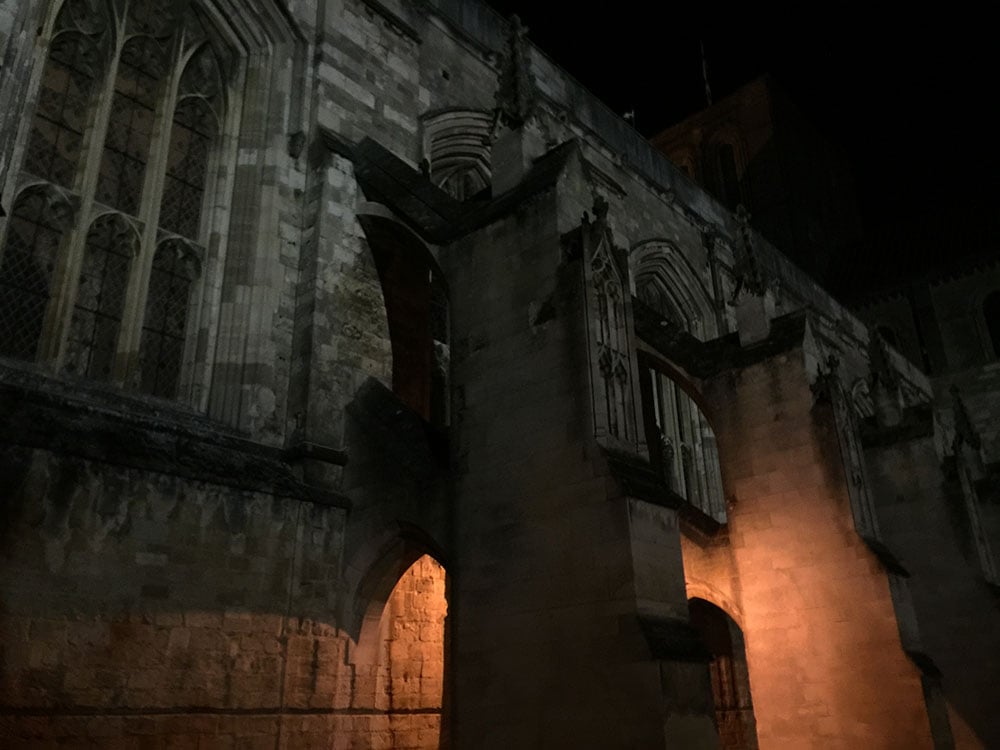
Winchester Cathedral
“Winchester Cathedral” is the title of an awful pop song from the 60s that I loved as a child, but now is the sort of retro banal ditty that I can’t stand. But Winchester Cathedral itself is awesome, in the way only a cathedral can be and I believe was meant to be. Awesome in a true sense of the word. Inspiring awe, an intense feeling that mixes fear and admiration in the face of God. I visited it at night twice, and the second time walked around more slowly, taking this picture on the building’s south exterior walls. It has the longest nave of any cathedral in Europe. And while the building dates back to the 11th Century, parts of it were completed as late as the 16th Century. Its creators are mostly unknown. Nearby, a group of people were rehearsing a musical in a second floor room overlooking the park around the cathedral. Their voices carried, and I could see them through the window, dressed in their everyday clothes, working together on the music. It was around 9 at night. I was very moved by their commitment to gather and rehearse in order to provide a delightful evening for others at some point in the future.
The Inn in Norton St. Philip
Bob designed a small development on the edge of a very old English village named Norton St. Philip. We visited the development and shot a scene for our documentary, then had lunch at The George Inn, which Bob said is one of Britain’s oldest taverns, dating back most probably to the 14th Century. He told us it had been a monk’s monastery at one point. It was a great place to have lunch.
Sir Joshua Reynolds
When you stand in someone’s house and see a work of art on the wall by one of the great masters of the form, and you are there as a guest, with a camera and license to shoot, it really is exciting. This painting is by Sir Joshua Reynolds, one of the greatest portrait painters of any era in any nation in any time. He happens to have been an 18th Century Brit. The painting is of a relative of Tim Everett, one of the owners of a house Bob designed in the early 21st Century on land the family owned for centuries but had never built on. A contemporary country home that can house up to 20 guests, it is wonderful – not ostentatious, but far from timid in its size and the power it was meant to have both on the landscape and for guests. Tim and his wife Grace were generous hosts, welcoming us in and sharing their time in a wonderful interview that is the core of the scene that focuses on Bob’s work designing country homes. To see a Reynolds that you’ve never seen because it’s still in the possession of the family that commissioned it is a rare treat. I always want to touch art. I put my hand on the frame. I dared not disturb the portrait itself. As for Grace’s relatives and the visual arts, her dad was one of the animators on the Beatles film “Yellow Submarine,” so there’s that.
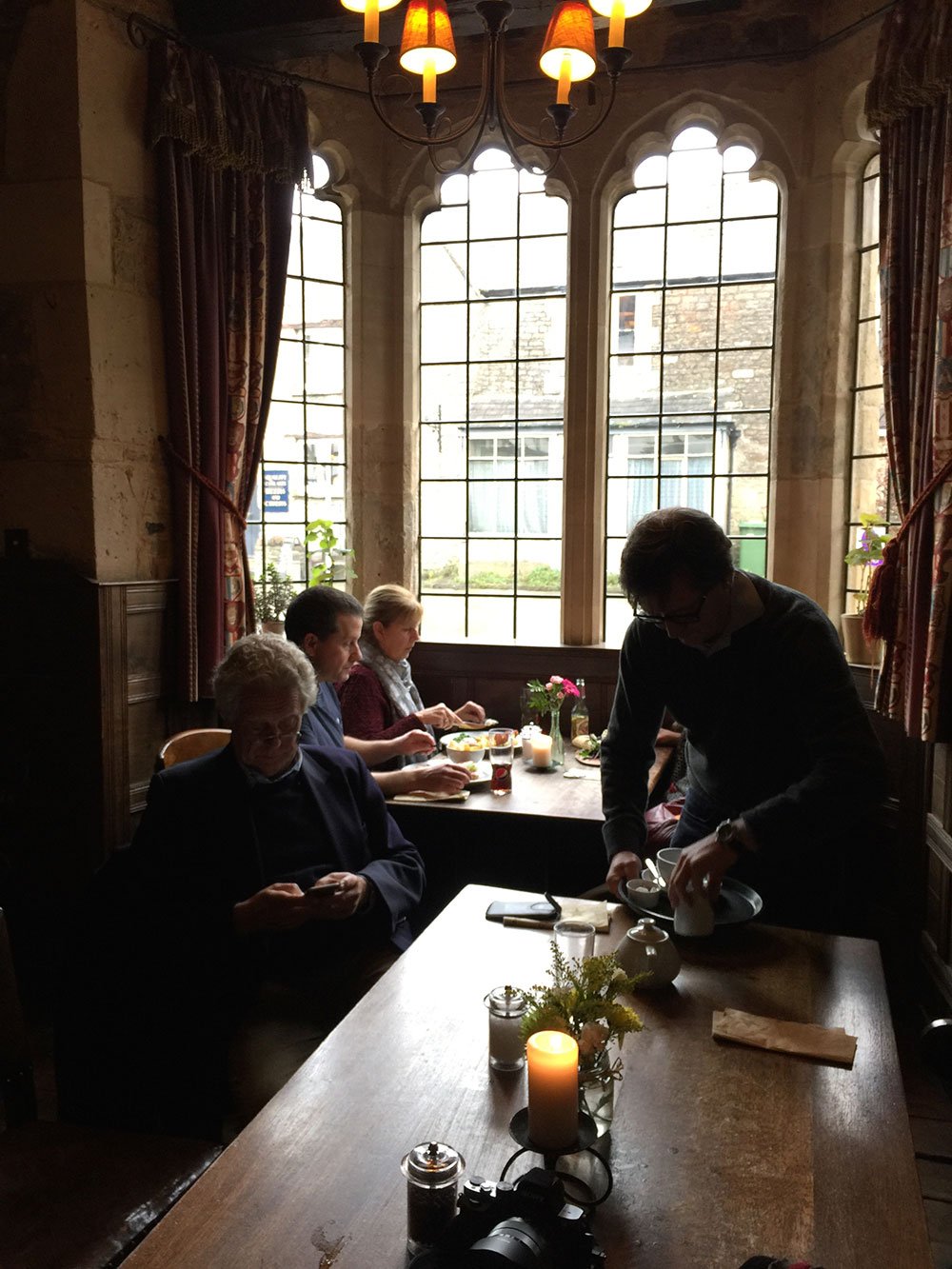
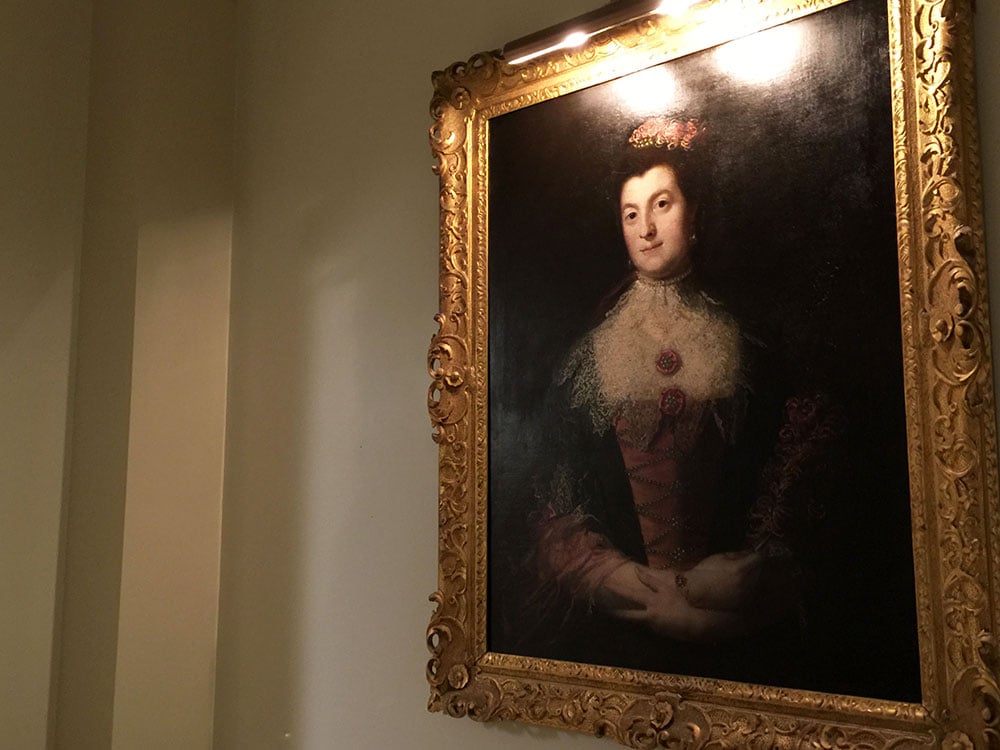
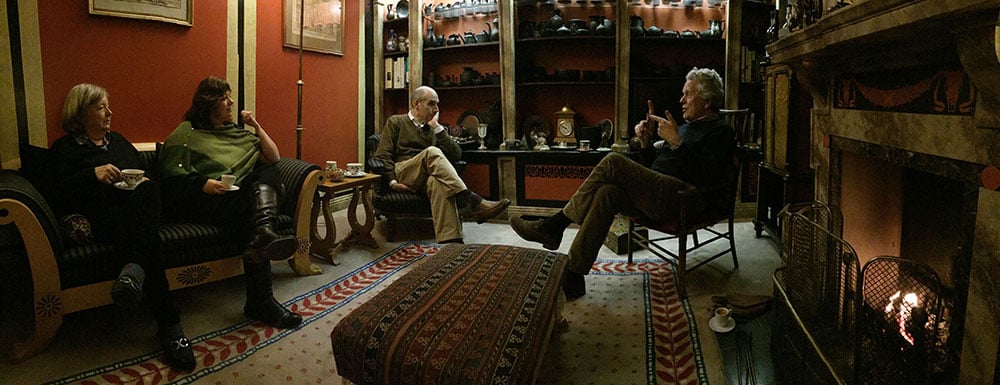
Relaxing at Crooked Pightle
I remember talking with Bob on the phone before we left Chicago to fly to London and saying, “I am guessing that the only thing we share is a language. I expect everything else to pretty much be a total surprise.” Crooked Pightle is a case in point. Bob lives on an unnamed and unnumbered road in an unincorporated area not far from Winchester. In order for people to know where you live, your house must have a name. Bob’s house is named Crooked Pightle, after the field on which it was built. And one night we were guests of Bob and his wife Sarah. We had a wonderful lamb dinner and talked and drank claret, and then retired to a room off the Great Hall, pictured here. All fine, but I didn’t know what claret was, except that it tasted good. It turns out claret is a British upper class term for Bordeaux. This room was a cozy place to hang after dinner. Right to left in this photo is Sarah Adam; Liz Reeves, the show’s co-writer and associate producer; host Geoffrey Baer; and our subject, Robert Adam. A clock Bob designed is in the background and this beautiful postmodern room holds a large collection of black Wedgewood. Bob was talking about Russia – mind you, this was all a few days before the Trump Administration began. It was on people’s minds.
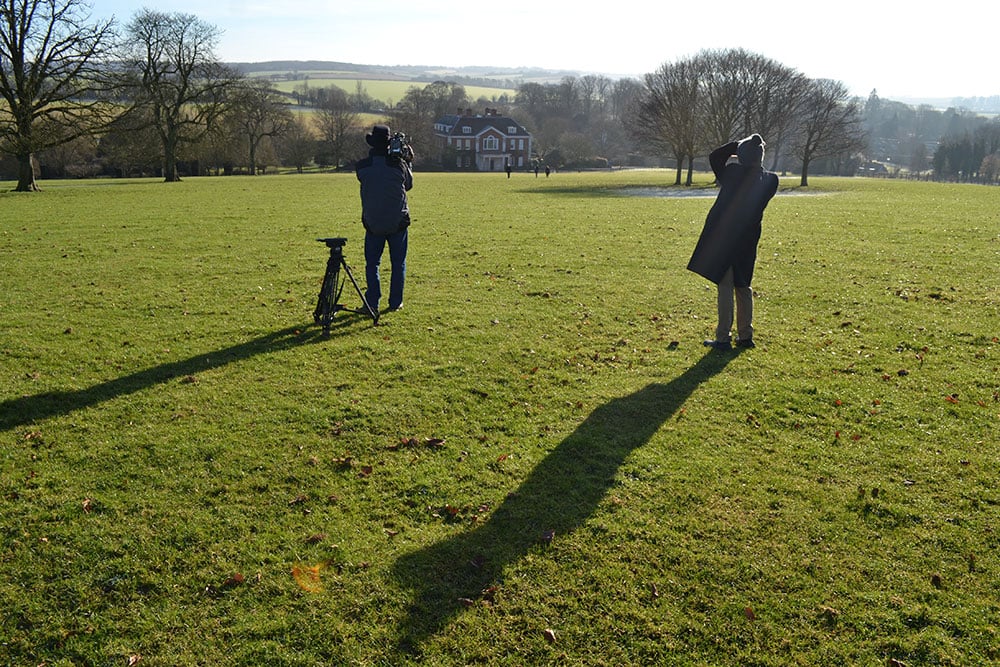
On the hill
To celebrate the Millennium, Bob was hired to build a folly, a small structure like a gazebo, on a hilltop overlooking a great house owned by Sir John Sainsbury, owner of one of Britain’s most successful grocery store chains. That’s cameraman Tim Boyd on the left and Geoffrey Baer on the right, taking photos and video of the hillside and Sainsbury’s home below. Bob and our crew, including Liz Reeves, are climbing the hill. This was the most beautiful day of shooting we had. The sun was out, the sheep were on the hillside, and at the top, behind all of us with cameras, was Bob’s Millennium Pavilion, the small structure that we close the documentary with. We started shooting under the dome that Bob says appears to float, a trick he claimed ancient civilizations hoped to achieve that is only now possible with modern technology. The light was great, Bob and Geoffrey were great, and we kept going. After nearly two hours of this, well over twice the time scheduled, Geoffrey said “Dan must like this place. He won’t stop shooting.” Bob worked hard to convince his client that the pavilion should be off to the right when viewed from the house, rather than dead center to the back door. He also arranged the columns so that the sun would rise directly between two of them on the first day of the Millennium, something that reminded me of Stonehenge. But Bob didn’t share that detail with the client out of concern that it might be erased in the review process as an unneeded concession to the stellar landscape. That is something I understood very well – there are many things in my own work that are known only to myself, and possibly an editor or cameraman, mostly to insure that they remain meaningful in a very personal way.

Alexander Stoddart takes a photograph
We flew up to Scotland to spend a few hours with sculptor Alexander Stoddart. Stoddart is privileged to do decorative sculpture for architects including Robert Adam, Greg Hamilton and John Simpson - contemporary traditionalists and classicists who have pushed against the edict so concisely articulated by Alfred Loos in his 1910 work “Ornament and Crime” – “We have out-grown ornament … soon the streets of the cities will glow like white walls!” White walls with sculpture by Stoddart on it. But the really interesting thing here is Stoddart using a smart phone to snap a picture of his own sculpture. This was shocking, because he went on about the horror of photography, characterizing it as like a theft, and brutal. But he didn’t like the angle we were attempting to shoot his sculpture from, so he took a picture to demonstrate why it was best viewed from his preferred angle. That’s our cameraman, Tim Boyd, behind Stoddart, taking note. Stoddart is the Queen’s Sculptor in Ordinary in Scotland, and therefore, by decree, a member of Scottish Royal household. He also delivers his barbs in a coat of humorous charm.
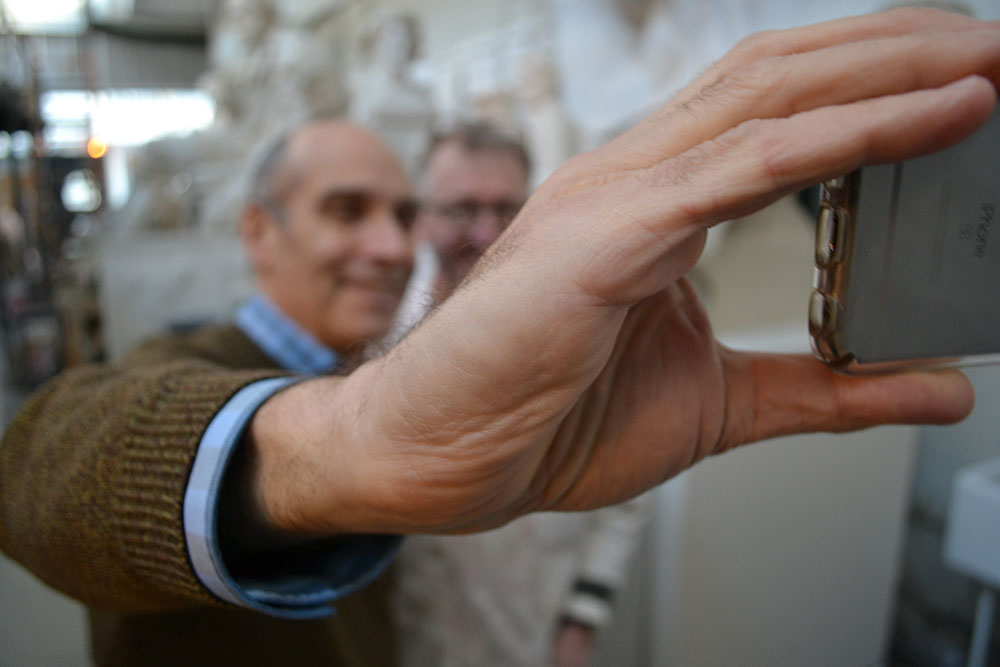
Geoffrey takes a selfie
Geoffrey Baer does not share Stoddart’s judgmental rejection of photography. In fact, he loves the selfie, as any followers of his Facebook page know. Here’s Geoffrey taking one with Stoddart. Me, I love taking pictures, and Stoddart’s well-reasoned and culturally thoughtful rejection of photography will never dissuade me. Geoffrey always asks me what I do with all the pictures I take. I use them to feel good about taking more photos, and I like to believe it strengthens my eye. Some of the photos I post here, in a blog like this.
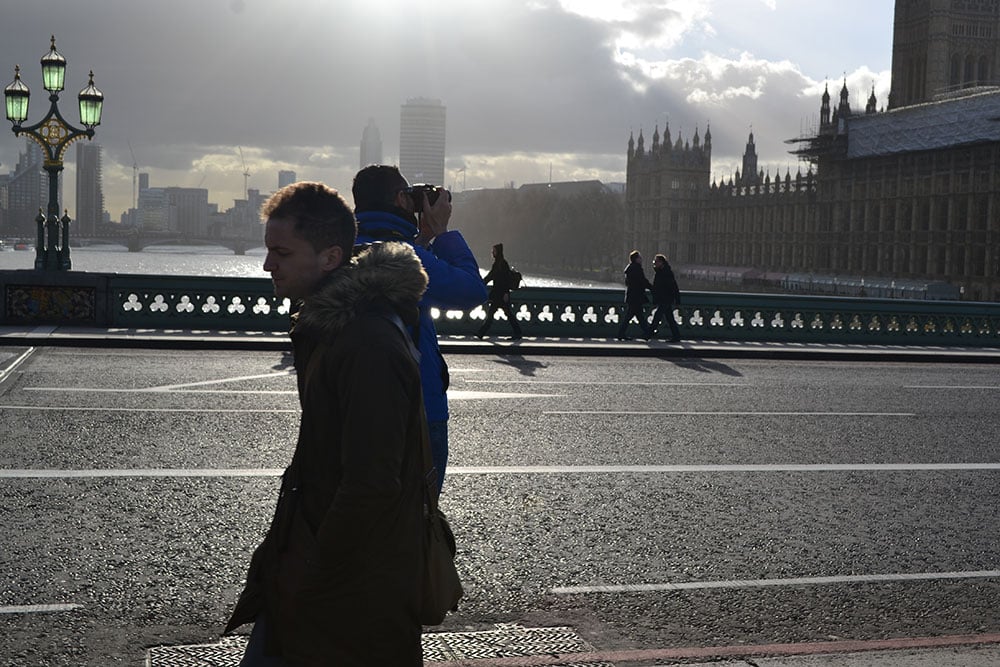
The Bridge
We have no images like this in our show, but it was a beautiful day on the Westminster Bridge and the backlight was extraordinary, as was the wonderful arbitrary crossing of people. Those are the Houses of Parliament caught in the overexposed haze on the right of the photo. I like the green glowing lamp post on the left, but mostly I like the two people caught at the center in this near union - the person with two heads. I could point you to a few brilliant examples of the trope from the history of photography – consider this a nod to greater greatness. One note: when I chose this picture to write about, it was before the horrible attack on the bridge on March 22, 2017, a day before our documentary aired for the first time. But indeed, this is the same bridge where four died and dozens more were injured in an incident that’s been labeled a terror attack.

The Royal Institute of British Architects
This is a building to see. We were there to record a debate that Bob participated in about the future of Clandon Park, an 18th Century mansion that was destroyed in a fire in 2015. It’s an art moderne/art deco masterpiece. From its elegant, stripped down exterior (featured in the show), to its incredible staircase (viewed here from the side), to its auditorium and large public rooms, including a great library, it is remarkable. Built for and paid for by the RIBA membership at the height of a worldwide depression in 1934, its architect, George Grey Wornum, was selected from thousands of entrants in a competition for the winning design. This cut-glass balustrade is a good example of its aesthetic glories. I love the geometries at play here. Architect and writer Witold Rzyczynski notably wrote “Glass balustrades are visually neat although vulnerable to sticky-fingered children.” These are probably cleaned daily.
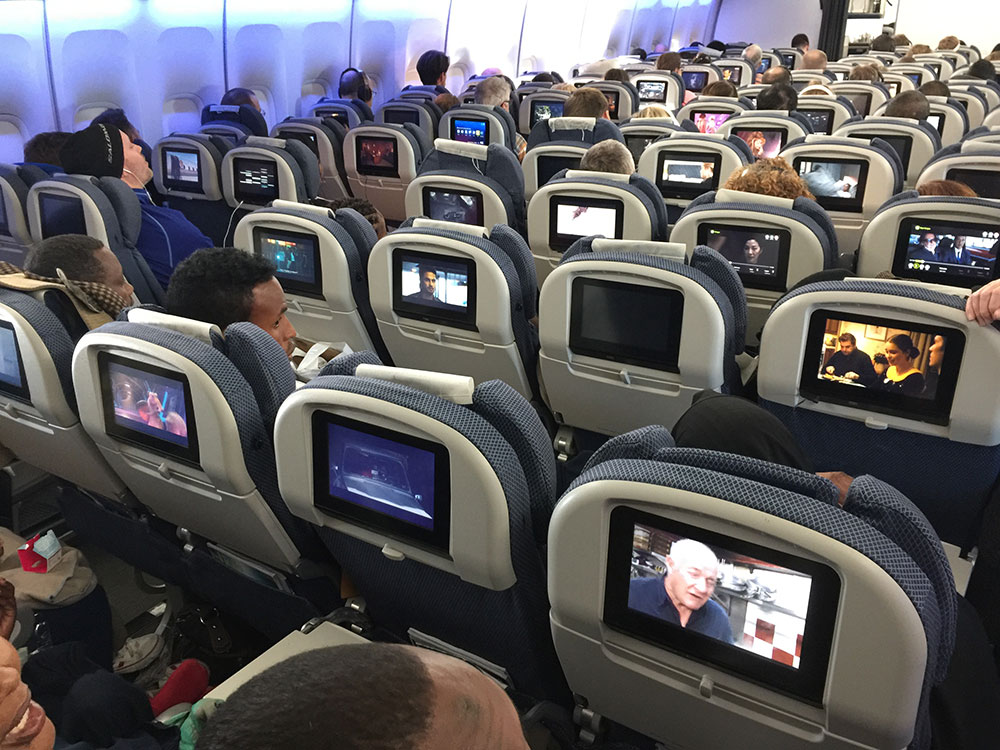
Homeward Bound
The jet home. A day before the Trump Inauguration. A Boeing 747 out of Heathrow. Last time I was on a 747 was in 1970 on a flight to California. I was a newspaper delivery boy on a trip to Disneyland with other newspaper delivery boys and girls, and a few of us wandered upstairs to the lounge at the top of the plane, where a few adults who actually could order a drink looked askance at us. Besides the fact that I can no longer wander aimlessly around a three-story jet airliner, there is no single in-flight movie screen anymore. Much like mini-vans and SUVs across the world, each seat is now equipped with its own screen, and you can select your own private viewing list. As far as I can tell no one was watching the same movies or shows. We sat in the back of the plane on the main level, sharing the ride with a couple dozen refugees from Darfur headed for a new life in Ohio. They sat next to us, watching their own TVs alongside the rest of us, as they took the next step in a long journey to a new life. I watched the documentary “Sour Grapes” about deception in the wine market, a couple of episodes of the Italian crime series "Gomorrah," "Genius," a film about writer Thomas Wolfe and his editor Maxwell Perkins and "The Grand Budapest Hotel."

